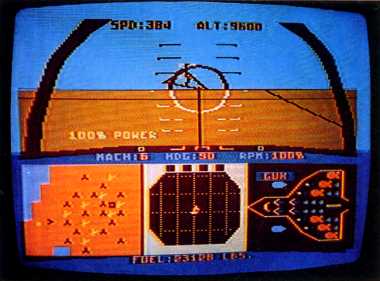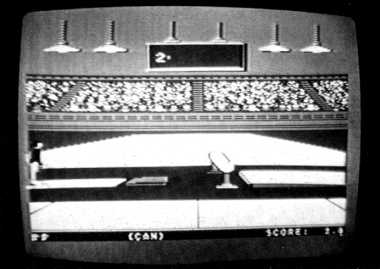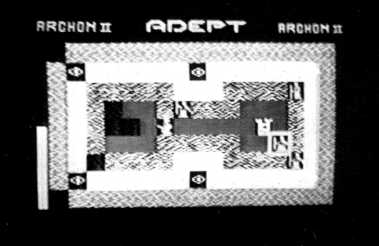Game Reviews
F-15 STRIKE EAGLE
Reviewed by Peter Ellison
F-15 STRIKE EAGLE
Reviewed by Peter Ellison
F-15 Strike Eagle is a game that simulates flying a fighter through seven different scenarios. Each Mission is based on an actual historical event, adding realism to the simulation.
I'm not a real fan of strategic, or war games, so, when I first looked at the package and saw the thirty-six page manual, I thought, "This game is not for me!" When I read in the manual that it required one to two joysticks, I knew that I'd better have a closer look.
After booting up the system and pushing start, I saw that there was something different about this game. The screen read `Authenticate and Enter Code.' So, I looked through the manual to find a part that read `Top Secret!,' and typed in the secret authorization code.
This game, written by Sid Meier, author of Hellcat Ace, and Major Bill Stealy, President of MicroProse, and fighter aircraft pilot for fourteen years, brings the F-15 Eagle home to you. I never thought I'd be able to feel what an F-15 fighter pilot might experience. With this excellent simulation, I can.
The screen shows the cockpit of an F-15 Eagle, including everything from the Heads-Up-Display (HUD), to the Instrument Panel. By pressing the spacebar, you're able to look out the rear of the aircraft. The rear view shows only the sky, ground or sea surface, and other aircraft or missiles. The HUD includes: Airspeed, Altitude, Aircraft ground reticle, air-to-air reticle, air-to-ground reticle and pitch lines, target designator box, missile designator box, and steering cue.
Besides having all of the aircraft systems information showing on the HUD, there are also a number of messages that appear from time to time. When you are firing your gun it replies by telling you how many rounds remain. `Missile Armed' appears when arming either a short, or a long-range missile. Other messages include `bomb armed,' `enemy plane hit,' `bombs released,' `bombs missed,' and `target hit.' As well as messages that appear on the screen, warnings are flashed on. These warnings are: `Alert: Sam Launched,' `Damage Warning,' `Alert: Air Missile.'
Also, when using defensive measures, messages appear referring to different actions. These messages indicate whether you're using long, medium, or short range radar, ECM Jamming, and Flare Released.
Up Front Controls (UFC) are operated by either the keyboard or second joystick. I found the keyboard a lot easier and faster to operate while flying, since I did not have to remember the positions of the second joystick. These UFC's include activate gun mode, activate short or medium range missile, arm bomb, throttle, afterburner, and many more commands. When first playing this game, I thought that I would never be able to remember all the commands, but after only a time or two, I had them all memorized.
Below the HUD, and to the right, is an outline of your Eagle, showing the Weapon Status Display. This shows how many bombs, short or medium missiles, and flares there are, and the fuel status. At a quick glance, it is easy to get the status of your weaponry.
One panel to the left is your radar display. The radar can be set at either long, medium, or short range. When I'm flying, I usually keep it at medium, switching to long for a quick scan, or to short when in close combat. The radar is interesting to watch after you have released a short or medium range missile to track down another fighter, or when you have released a flare to mislead a missile which has been fired toward you.

The final panel to the left shows the horizontal situation display (HSD). This panel marks out the different Sam missile sites, airfields, primary targets, and the F-15 base. A navigation cursor can be moved around this screen by the use of the control arrows on the keyboard. To designate a target, you move the cursor to the top of the location you want to bomb. The steering cue, which is located on your HUD, will now be the direction in which you want to fly. If you continue to fly in this direction, you will eventually reach your destination. All this equipment makes air combat exciting.
There are seven missions, as explained in the first paragraph: Libya, August 19, 1981, Egypt, October 6, 1973, Haiphong, April 15, 1972, Syria, March 12, 1984, Hanoi, May 10, 1972, Iraq, June 7, 1981, and Persian Gulf, June 5, 1984. Each mission consists of bombing airfields, SAM'S, and one to three primary targets. Once all the primary targets are destroyed, and your fighter returns to base, the mission is over. You are able to destroy a few SAM's or airfields, and return to base to refuel, make repairs, and replenish weapons, and then to continue the mission. The more things you destroy, the more points you receive; but to continue onto the next mission, you must make it back to your base, or bail out and be rescued.
The aircraft which you'll encounter range from a Mikoya/Gurevich Mig-21 to a Sukhoi Su-22. SAM's fire SA-2: Ground to air missiles (radar guided), SA4: Ground radar guided and semi-active radar homing in terminal phase, and SA-7: Hand-held, infra-red missiles.
The simulation has four skill levels: Arcade, Rookie, Pilot, and Ace. The arcade level is more for the beginner because the aircraft does not roll, and it enables one to become familiar with the instrumentation and weapons. Rookie is what I usually play (at this time), but when I want a real challenge, I select ACE. With that, I don't last too long, but it's fun trying.
The instructions or flight operations manual is one of the best documentations of any game or simulation that I've played. Thirty six informative pages concerning F-15 specifications, weapons, cockpit layout, diagrams, and aerodynamics, makes this manual, in itself, a learning experience. I was never interested in fighter aircraft until I read this manual. I rarely enjoy reading documentation, but for this game, it was worth it.
F-15 Strike Eagle is one of the best games that I've seen for a long time. This game involves strategy, good reflexes, and skill, which makes it challenging for anyone, whether an arcade or strategy game player. This simulation combines the two for an entertaining game that will keep you busy for years to come. To be able to fly a $20,000,000 aircraft for a suggested retail price of $34.95 for the game, is a steal.
F-15 STRIKE EAGLE
MicroProse Software
10616 Beaver Dam Road
Hunt Valley, MD 21030
Ratings
Playability: 9.5
Challenge: 10
Graphics: 9.2
Sound: 8.0
Documentation: 10
Overall: 9.5
SUMMER GAMES
Reviewed by Gabe Torok
Reviewed by Gabe Torok
Here I am, the closest I get to a sport, any sport, is a beer and television, and all of a sudden I am required to participate in the Olympics. No, not the Special Olympics! I don't consider my spare tire a handicap, rather, extra energy stored studiously for moments just like this.
The Olympics in which I participated several times was the 1984 Summer Games, produced for my frustration by Epyx. I say frustration because I performed about the same as if I had been there in person. Perhaps my lack of T-shirt sales would have added to my losses, so I may consider losing in the privacy of my own home a blessing. Who wrote this program, anyway? Just how many Olympians are computer programmers, that can produce such realism, with such fantastic graphics?

With nine countries to choose from, I may have kept picking the losers. After the anthem, the opening ceremonies, and a careless look at the instructions, I was ready. Or so I thought. The first event was the pole vault. I'm not good with heights, but I gripped my pole and gave it a good run. Got the pole firmly set into the vault box, - and forgot to let go. FAULT! They gave me a second chance. Better. I let go of the pole, perhaps some would say a little too soon. FAULT! They were really nice about the whole thing. One last chance, and I flubbed it. Perfect vault, perfect release, graceful drop, hard landing. I missed the mat. Not even a bronze for this one, I thought. Wrong! As I was the only one competing, I got the gold!
The next event was much better. Diving from a sofa is not at all difficult. I performed like a veteran, full tuck position, layout or pike, you name it. I felt like Bo Derek when I saw all the scores come in. I did so well, they let me do several types of dives until my score got back to a normal low. But I still got the gold.
The 4x400 Meter Relay played havoc with my Joystick but I managed to keep up with the computer pacer. It really felt good to win again.
After the exertion of the relay, a cooling pint of beer, a bag of pretzels, and a life-giving cigarette, I was ready for the 100 yard dash. Piece of cake after my previous success, and I chalked up another gold with little trouble.
Gymnastics'? Me? You gotta be kidding! I sat up straight, mustered all my concentration, pressed the start button, sprang, and missed the horse. (No, really, that's what they called it. The only resemblance I could see were the four legs and the saddle on which I caught myself on the second try.) The third try revealed to me why the name `horse.' I made a perfect vault, flipped, turned in mid air, came down almost feet first. Where I landed reminded me of my last pony ride, and the pain that followed. (In those days they used to call me `tall in the saddle' until my blister broke.)
Now you're cookin'. Swimming is what I do best. The water holds all my parts in a streamlined bouyancy that allows me to imitate a veritable torpedo. No-one ever told me I had to push a joystick button to use my notorious power stroke? I was much better on the second lap, and almost great on the third. Thus, my sixth gold. The seventh came on the 100 meter freestyle, by which time I mastered the intricacies of pushbutton control.
Skeet Shooting'? Terrific!!!! Finally, I can rest a bit after the strenuous events of the past half hour! (They don't even give you time to change.) There I was in this half circle somewhere, looking for the skeets. Nothing happened. Moving the joystick revealed the location of my shotgun, and reading the instructions revealed the release mechanism for the doves (or pigeons, depending on where you live). I hit the button, releasing the pigeon, aimed, pressed the button again, but the little blighter was too fast for me. I tried again, but they're sneaky! They came at me from a different direction, and caught me unprepared. This time ...I thought; I quickly pressed the button, somehow knowing they would come at me from the opposite side. I aimed and fired, creating hole number one in a newly proposed golf course. Mustering all my concentration, and getting the lay of things, I managed to end the sorrowful life of the next four pigeons. Surely there's a cleaner way to win a gold?
Summer Games
EPYX Inc.
Playability:9
Exercise value: 10
Graphics: 10
Sound: 8
Objections: Having to turn the disk back and forth through the first
few events.EPYX Inc.
Playability:9
Exercise value: 10
Graphics: 10
Sound: 8
Archon II
Reviewed by Gavin Bamber
Reviewed by Gavin Bamber
Clear your mind of all thoughts. Now, picture a barren island upon which there are two citadels. Listen to the gentle lapping of waves against the shore. Smell the fresh air. Look! Beyond the water is a sea of flames!
This is the magic realm where the Master of Order and the Mistress of Chaos fight for the supremacy of the world.
Attending these warlords are a few adepts, one for each of the classical elements composing this zone of magic: Air, water, earth, and fire. In turn, the adepts have assistants, four types of elements, and four forms of demons, which can be conjured up at a moment's notice.
Magic reigns supreme here as Order and Chaos vie for the constantly moving power squares. Spells are cast: Summon (to bring in a demon or elemental), heal, weaken, imprison, release, banish, and the ultimate: Apocalypse.
Watch as Chaos summons an elemental, the Siren, and moves it to a square occupied by the enemy Kraken. A battleground containing pools of water appears as the fighters assess each other's supply of energy. The Siren sings a sweet but deadly song which causes the slow-firing Kraken to lose strength. Quickly the Kraken generates a tidal wave across the water, and knocks the Siren into oblivion.
And so goes the game as each duel is fought in battlefields of rock, fire, air, or water. Spells are cast. and power squares conquered until it is time for the final battle.

This apocalyptic battle is the beginning of the end as the Master of Order and Mistress of Chaos fight to the death in the void where one's strengths and weaknesses depend on the amounts of energy, icons, and adepts left intact.
To return to the real world: "Archon II: Adept" is a much improved upon version of Archon. The additional spells, plus the shifting power squares, add a greater challenge to the players who are well aquainted with Archon.
One of the best features of this game is that there are three skill levels, so that one's capabilities may be matched pretty evenly with those of an opponent, whether human or computer. Beware though, the computer becomes trickier as you progress; the Adept is adaptable.
It is unfortunate that the instruction manual is rather short and to the point. In my view, Electronic Arts should have explained the situation in more detail, and the backgrounds of the icons were too brief. But, I suppose, something should be left up to the imagination of the players.
Archon was considered by many to be the best Atari game of 1983, and Archon II: Adept is sure to have that distinction in 1984.
It is equally remarkable that as a sequel to Archon, the Adept is not a copy of the original. It can be enjoyed by those who have Archon, as I do, as well as by those who don't, because it is quite different.
Overall, the game is great fun and challenging, with a good variety of playing pieces and screens. The graphics and sound effects for each element and icon are quite unique.
ARCHON II: ADEPT
Electronic Arts
2755 Campus Drive
San Mateo, CA 94403
Ratings
Graphics: 10
Challenge: 9
Sound: 10
Documentation: 8.5
Holds Interest: 10
Overall Rating: 9.5
Electronic Arts
2755 Campus Drive
San Mateo, CA 94403
Ratings
Graphics: 10
Challenge: 9
Sound: 10
Documentation: 8.5
Holds Interest: 10
Overall Rating: 9.5